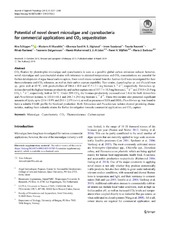Potential of novel desert microalgae and cyanobacteria for commercial applications and CO2 sequestration
Schipper, Kira; Al Muraikhi, Mariam; Alghasal, Ghamza Saed H.S.; Saadaoui, Imen; Bounnit, Touria; Rasheed, Rihab; Dalgamouni, Tasneem; Al Jabri, Hareb Mohammed S.J.; Wijffels, Rene Hubertus; Barbosa, Maria
Peer reviewed, Journal article
Published version

View/
Date
2019Metadata
Show full item recordCollections
Original version
https://doi.org/10.1007/s10811-019-01763-3Abstract
CO2 fixation by phototrophic microalgae and cyanobacteria is seen as a possible global carbon emissions reducer; however, novel microalgae and cyanobacterial strains with tolerance to elevated temperatures and CO2 concentrations are essential for further development of algae-based carbon capture. Four novel strains isolated from the Arabian Gulf were investigated for their thermotolerance and CO2-tolerance, as well as their carbon capture capability. Two strains, Leptolyngbya sp. and Picochlorum sp., grew well at 40 °C, with productivities of 106.6 ± 10.0 and 87.5 ± 2.1 mg biomass L−1 d−1, respectively. Tetraselmis sp. isolate showed the highest biomass productivity and carbon capture rate of 157.7 ± 10.3 mg biomass L−1 d−1 and 270.8 ± 23.9 mg CO2 L−1 d−1, respectively, both at 30 °C. Under 20% CO2, the biomass productivity increased over 2-fold for both Tetraselmis and Picochlorum isolates, to 333.8 ± 41.1 and 244.7 ± 29.5 mg biomass L−1 d−1. These two isolates also presented significant amounts of lipids, up to 25.6 ± 0.9% and 28.0 ± 2.0% (w/w), as well as presence of EPA and DHA. Picochlorum sp. was found to have a suitable FAME profile for biodiesel production. Both Tetraselmis and Picochlorum isolates showed promising characteristics, making them valuable strains for further investigation towards commercial applications and CO2 capture.
